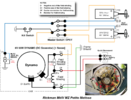I have a late 1960s vintage motorcycle built with a motor from East Germany. The alternator is a field wound unit that puts out around 60w. Originally, this motor was designed for a motorcycle that had lights, battery, and a regulator/rectifier. The motor was transplanted into a racing frame and successfully raced. I purchased it a few years ago and it needed some TLC. I've got the machine sorted except for the ignition side.
As a racing machine there's no room for a battery or the big clunky mechanical regulator designed for these engines. Unfortunately a mouse got inside the alternator case and ate all the wires. Also, the previous owner cut out the entire wiring harness, so I have no idea how this machine operated electrically.
I know the alternator does not have permanent magnet, The field coil is around 1.7 ohm and there's a 4.4 ohm "field resistor". In struggling to understand how this motor operated I've concluded it can't run without a regulator/rectifier. In chatting with people who own machines with the same motor I've been told it can't run without a battery. It obviously needs a battery to energize the core to enable ignition, but I don't understand why a start battery couldn't be removed after the engine fired up.
My guess is that this bike was operated with a small battery pack to get things running and a small 6v regulator/rectifier hidden someplace. Once running, the machine competed in long distance desert races with interim stops for fuel. After a long run I'm thinking the core would retain sufficient residual magnetism to support kick starting the bike for the next leg.
Field-wound alternators in cars can run without a battery, although it's not wise on modern autos packed full of sensitive electronics. I'm not sure why folks are telling me this alternator must have a battery. And I have no idea how to source a 6v regulator/rectifier for this alternator and what specs to look for. I'm cautious about zapping the field coil to test for spark because I have no idea how much current would be needed to energize the coil without frying it. I might try sneaking up on it in 1/4 amp increments to see what it takes to get a spark,, but without a regulator I certainly wouldn't run the motor.
I've verified the integrity of the field coil and armature, and I know the ignition side (points, condenser, coils) produced a nice blue spark when hooked to a DC power supply. But I'm full stop until I can figure out the business of finding a regulator/rectifier and confirming that running without a battery is tenable.
I've attached a wiring diagram based on where I am at this point. I am very grateful for any advice on how to proceed - any thanks in advance for taking time to lend a hand.
As a racing machine there's no room for a battery or the big clunky mechanical regulator designed for these engines. Unfortunately a mouse got inside the alternator case and ate all the wires. Also, the previous owner cut out the entire wiring harness, so I have no idea how this machine operated electrically.
I know the alternator does not have permanent magnet, The field coil is around 1.7 ohm and there's a 4.4 ohm "field resistor". In struggling to understand how this motor operated I've concluded it can't run without a regulator/rectifier. In chatting with people who own machines with the same motor I've been told it can't run without a battery. It obviously needs a battery to energize the core to enable ignition, but I don't understand why a start battery couldn't be removed after the engine fired up.
My guess is that this bike was operated with a small battery pack to get things running and a small 6v regulator/rectifier hidden someplace. Once running, the machine competed in long distance desert races with interim stops for fuel. After a long run I'm thinking the core would retain sufficient residual magnetism to support kick starting the bike for the next leg.
Field-wound alternators in cars can run without a battery, although it's not wise on modern autos packed full of sensitive electronics. I'm not sure why folks are telling me this alternator must have a battery. And I have no idea how to source a 6v regulator/rectifier for this alternator and what specs to look for. I'm cautious about zapping the field coil to test for spark because I have no idea how much current would be needed to energize the coil without frying it. I might try sneaking up on it in 1/4 amp increments to see what it takes to get a spark,, but without a regulator I certainly wouldn't run the motor.
I've verified the integrity of the field coil and armature, and I know the ignition side (points, condenser, coils) produced a nice blue spark when hooked to a DC power supply. But I'm full stop until I can figure out the business of finding a regulator/rectifier and confirming that running without a battery is tenable.
I've attached a wiring diagram based on where I am at this point. I am very grateful for any advice on how to proceed - any thanks in advance for taking time to lend a hand.


